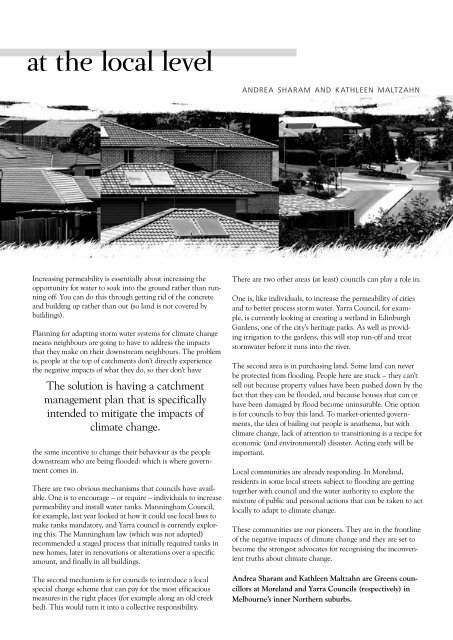news & views - Australian Greens
news & views - Australian Greens
news & views - Australian Greens
You also want an ePaper? Increase the reach of your titles
YUMPU automatically turns print PDFs into web optimized ePapers that Google loves.
at the local level<br />
Increasing permeability is essentially about increasing the<br />
opportunity for water to soak into the ground rather than running<br />
off. You can do this through getting rid of the concrete<br />
and building up rather than out (so land is not covered by<br />
buildings).<br />
Planning for adapting storm water systems for climate change<br />
means neighbours are going to have to address the impacts<br />
that they make on their downstream neighbours. The problem<br />
is, people at the top of catchments don’t directly experience<br />
the negative impacts of what they do, so they don’t have<br />
The solution is having a catchment<br />
management plan that is specifically<br />
intended to mitigate the impacts of<br />
climate change.<br />
the same incentive to change their behaviour as the people<br />
downstream who are being flooded: which is where government<br />
comes in.<br />
There are two obvious mechanisms that councils have available.<br />
One is to encourage – or require – individuals to increase<br />
permeability and install water tanks. Manningham Council,<br />
for example, last year looked at how it could use local laws to<br />
make tanks mandatory, and Yarra council is currently exploring<br />
this. The Manningham law (which was not adopted)<br />
recommended a staged process that initially required tanks in<br />
new homes, later in renovations or alterations over a specific<br />
amount, and finally in all buildings.<br />
The second mechanism is for councils to introduce a local<br />
special charge scheme that can pay for the most efficacious<br />
measures in the right places (for example along an old creek<br />
bed). This would turn it into a collective responsibility.<br />
ANDREA SHARAM AND K ATHLEEN MALTZAHN<br />
There are two other areas (at least) councils can play a role in.<br />
One is, like individuals, to increase the permeability of cities<br />
and to better process storm water. Yarra Council, for example,<br />
is currently looking at creating a wetland in Edinburgh<br />
Gardens, one of the city’s heritage parks. As well as providing<br />
irrigation to the gardens, this will stop run-off and treat<br />
stormwater before it runs into the river.<br />
The second area is in purchasing land. Some land can never<br />
be protected from flooding. People here are stuck – they can’t<br />
sell out because property values have been pushed down by the<br />
fact that they can be flooded, and because houses that can or<br />
have been damaged by flood become uninsurable. One option<br />
is for councils to buy this land. To market-oriented governments,<br />
the idea of bailing out people is anathema, but with<br />
climate change, lack of attention to transitioning is a recipe for<br />
economic (and environmental) disaster. Acting early will be<br />
important.<br />
Local communities are already responding. In Moreland,<br />
residents in some local streets subject to flooding are getting<br />
together with council and the water authority to explore the<br />
mixture of public and personal actions that can be taken to act<br />
locally to adapt to climate change.<br />
These communities are our pioneers. They are in the frontline<br />
of the negative impacts of climate change and they are set to<br />
become the strongest advocates for recognising the inconvenient<br />
truths about climate change.<br />
Andrea Sharam and Kathleen Maltzahn are <strong>Greens</strong> councillors<br />
at Moreland and Yarra Councils (respectively) in<br />
Melbourne’s inner Northern suburbs.












